23 Fuzzy Leaf Succulent Species (With Pictures)
Some species of succulents have small hairs on their leaves and can appear in different forms depending on the species, short, long, very soft or a little harder. The hairs, whose technical term is trichomes, are more or less delicate plant organs, which can fulfill various functions in plants.
Like the wax of many succulent leaves, the hairs of some succulents are part of their adaptation to the environment and their functions are varied and even opposed. Among them may be avoiding the loss of water from the plant or being able to capture water from the dew, protection against insects, or perhaps protection to avoid the excessive incidence of light on the surface of the leaves or adverse weather conditions.
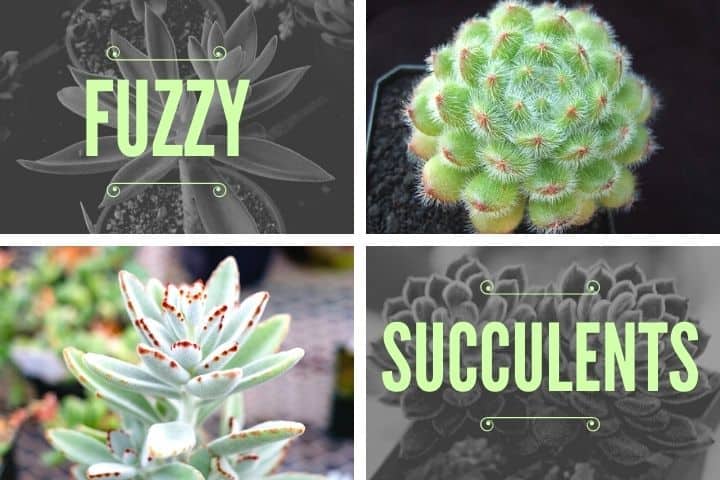
Contents
- 1 Fuzzy Leaf Succulent Species List
- 1.1 Aeonium smithii
- 1.2 Aichryson laxum
- 1.3 Aichryson tortuosum
- 1.4 Cotyledon tomentosa
- 1.5 Cotyledon tomentosa subs. ladismithiensis
- 1.6 Crassula barbata
- 1.7 Crassula namaquensis
- 1.8 Crassula pubescens
- 1.9 Crassula rogersii
- 1.10 Crassula sericea
- 1.11 Crassula setulosa
- 1.12 Crassula tecta
- 1.13 Crassula tomentosa
- 1.14 Crassula velutina
- 1.15 Echeveria cv. Bombycina
- 1.16 Echeveria coccinea
- 1.17 Echeveria setosa
- 1.18 Kalanchoe eriophylla
- 1.19 Kalanchoe tomentosa
- 1.20 Sedum mocinianum
- 1.21 Tylecodon leucothrix
Fuzzy Leaf Succulent Species List
Hairy succulent species are very attractive and here are some examples of them.
Aeonium smithii
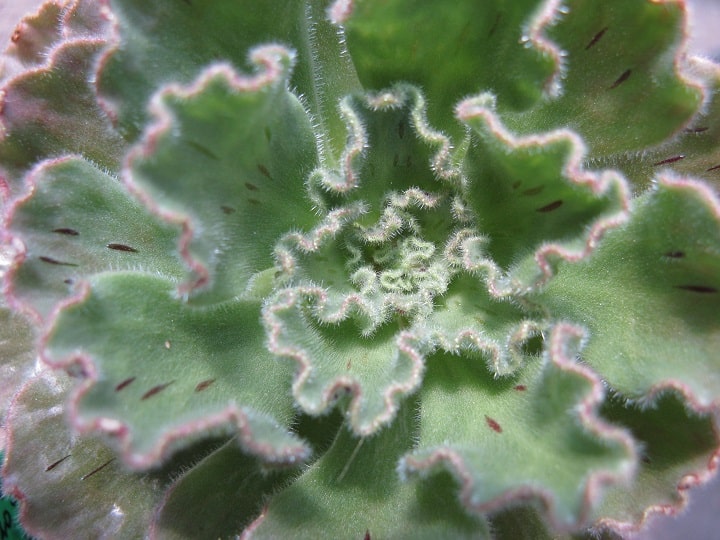
Aeonium smithii, also known as Sempervivum smithii, is a type of plant that grows up to 24 inches tall. It is a succulent shrublet that sheds its leaves every year. One interesting feature of this plant is that the leaves have spots on the underside only. When these leaves fall off, there is a row of stiff hairs along the lower edge of the scars. As the leaves continue to fall, the plant becomes more hairy, and the stem becomes shaggy. However, older stems tend to lose these hairs.
The leaves of Aeonium smithii are shaped like spoons and have wavy edges. They are deep green with red stripes on both sides. If you touch the leaves, they feel soft and velvety, and they look shiny on the upper surface. This plant produces a lot of flowers. The flower stalks can grow up to 6 inches above the clusters of leaves. The flowers are yellow and measure about 1 inch across. They usually have 10 to 12 petals, eighteen stamens, and 10 to 12 pistils.
Aichryson laxum
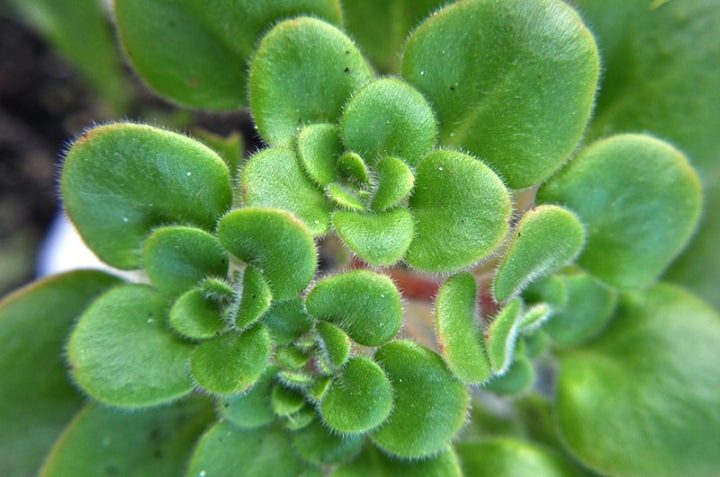
Aichryson laxum is a plant that can live for one or two years. It is not very common, and it can be delicate and easily broken. The plant is usually about 6 to 16 inches tall, but sometimes it can grow up to 32 inches or even 80 inches tall. The whole plant is covered in soft, short hairs that are up to 0.16 inches long. The leaves of the plant are green, but they can turn reddish if they receive a lot of sunlight. The leaves are hairy and can grow up to 3 inches long. They are arranged in clusters at the end of the stems.
The plant produces clusters of flowers that look like stars. Each cluster can have up to 50 yellow flowers. Aichryson laxum is very similar to another plant called Aichryson porphyrogennetos Bolle, but there are a few differences. Aichryson laxum has soft, hairy leaves with long stems, while Aichryson porphyrogennetos Bolle has different leaves. The leaves of Aichryson laxum are wider near the base, and the flowers are a medium shade of yellow. The hairs on Aichryson laxum’s leaves are not glandular, and the leaves do not have black glands at the edges.
Aichryson tortuosum
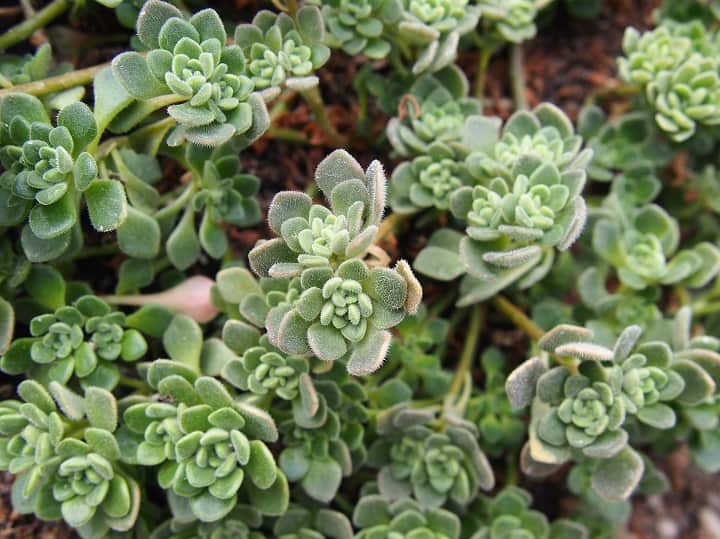
Aichryson tortuosum is a small and beautifully decorative plant that comes back year after year. It looks like a small shrublet and can grow up to 4 to 6 (rarely up to 8) inches tall. Its branches are twisted and crooked, which is why it’s called “tortuosum.” The plant has tightly packed, thick, and fuzzy leaves that grow in clusters, making it look like a tiny version of Aeonium lindleyi. The leaves feel soft and have a fine layer of hair on them.
This adorable little plant produces small yellow flowers that are not very tightly packed together. Usually, these flowers have seven or eight petals. The plant itself is actually an older and well-known type called Sempervivum tortuosum. It can look slightly different from other Aichryson plants because it can vary in appearance. However, the true, unhybridized version of this plant is rarely seen being grown by people.
Cotyledon tomentosa
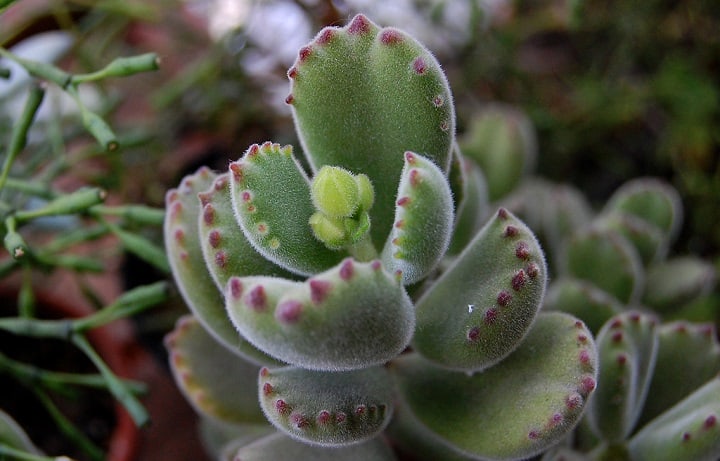
Cotyledon tomentosa, also known as Bear’s Paw or Kitten Paw, is a small succulent plant that comes from Africa. It can grow to be around 12-28 inches tall and 12-20 inches in diameter. The plant has many branches that can be close together or spread out. Just like other tomentose plants, Cotyledon tomentosa has leaves, flowers, and stems covered in a soft downy layer.
The leaves of this plant are like grapes or thumbs in size. When you touch them, they feel plump and soft, just like the adorable little paws of a baby animal. The leaves even have red markings that look like tiny toenails. In the spring, Cotyledon tomentosa produces large, bell-shaped flowers that are orange in color.
Cotyledon tomentosa subs. ladismithiensis
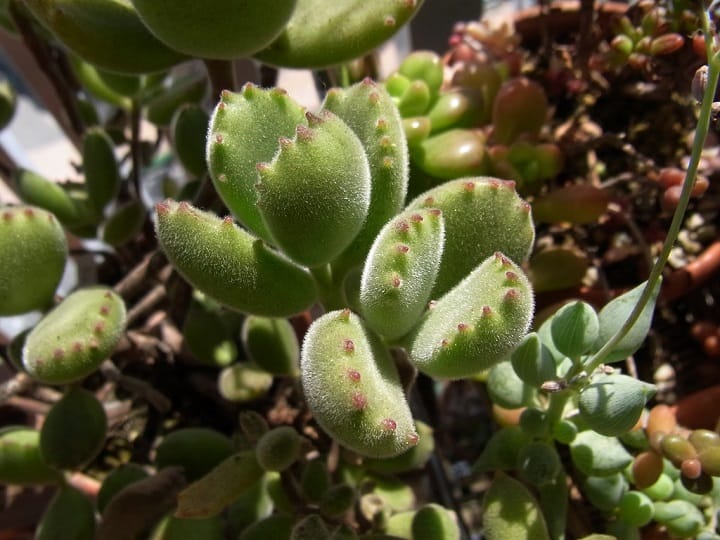
Cotyledon tomentosa subsp. ladismithiensis, also known as Cat’s Paw, is a rare plant that keeps growing and branching out. It is a succulent shrublet that’s a bit different from the more common Cotyledon tomentosa subsp. tomentosa. You can tell them apart by comparing their leaves, size, and how the flowers grow.
The subsp. ladismithiensis has stronger branches and can grow up to 3 feet tall, including the flowers at the top. The leaves are shaped like oblong ellipses or long cylinders. They are yellow-green and covered in a soft, downy layer. The leaves usually have a few sharp teeth at the top. Just like other plants with a tomentose texture, the leaves, flowers, and stems of this plant are covered in a dense, woolly coating that gives them a fuzzy appearance.
The flowers of this plant hang down like pendulums and are red in color. They look similar to the flowers of another plant called Cotyledon orbiculata.
Crassula barbata
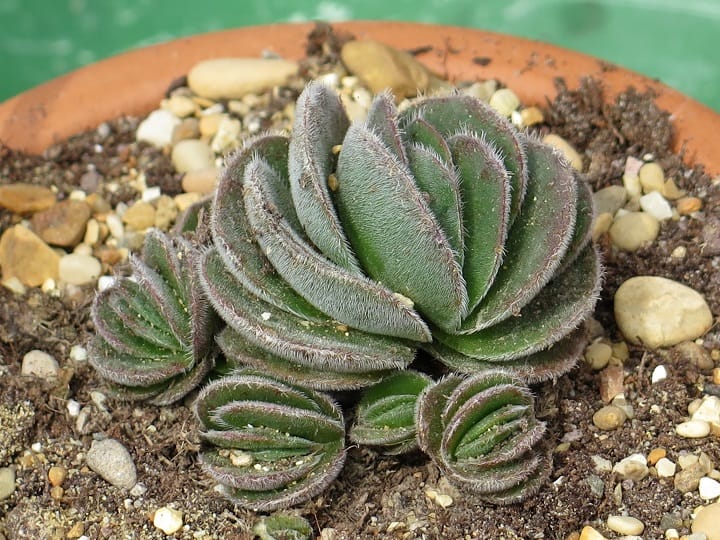
Crassula barbata, also known as Bearded Leaved Crassula, stands out among the fuzzy succulent plants and usually lives for a year or two. It forms a rosette shape with its leaves arranged in a spiral pattern. As the plant grows taller, it can reach up to a foot high, including the flowers. The older leaves stay attached to the stems even as new ones form.
The leaves of Crassula barbata don’t have any hair on them, except for a unique feature at the top. The tips of the leaves have long, white hairs that spread out, giving them a bearded appearance. In the springtime, the plant produces spikes of small flowers. These flowers can be either white or slightly pinkish.
As the plant grows and prepares to flower, the rosette in the center will open up and stretch, forming a tall stem for the flowers. After the plant flowers, the rosette will eventually die. However, there is a silver lining. Usually, as the rosette dies, it produces multiple new rosettes at the base. These baby rosettes can be separated from the dying plant and grown independently, starting the cycle all over again.
Crassula namaquensis
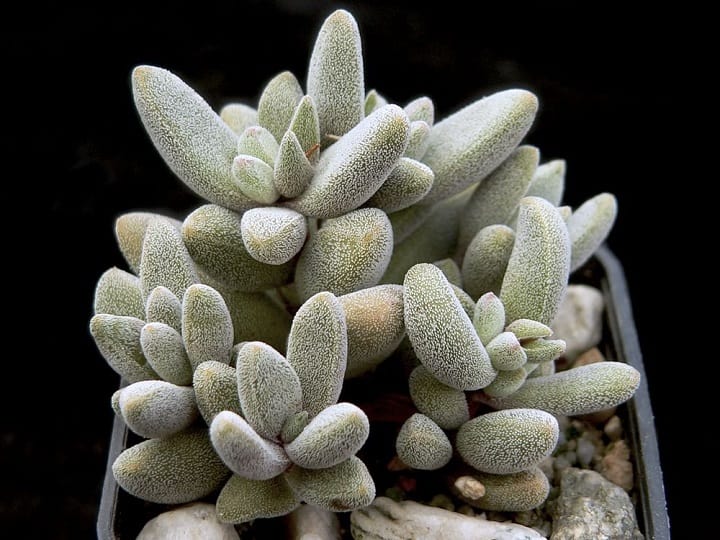
Crassula namaquensis is a tiny succulent plant that looks like a small shrub and can grow up to 4 inches tall. It has a thick base and the leaves are arranged in clusters that twist around the stem. The leaves of this plant feel soft and have a fuzzy texture. They come in shades of pale blue to blue-green because of the special hairs that cover them. It’s like a natural blanket for the leaves!
The plant produces flowers at the very top, grouped together in a tight bunch. These flowers are white in color. Crassula namaquensis is related to another plant called Crassula tecta, which means they have some similarities.
Crassula pubescens
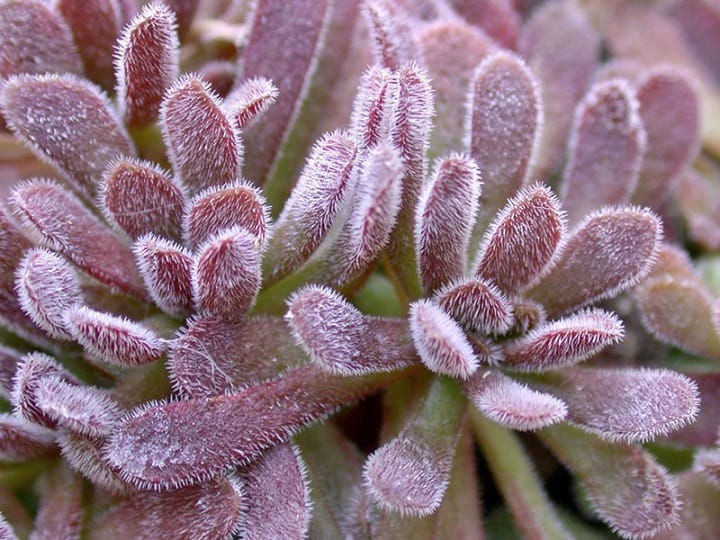
Crassula pubescens is a small, bush-like fluffy succulent that stays green all year round and can reach a height of 12-28 inches, with some growing up to 2-3 feet. It often grows in tight groups, so you’ll see many of these plants close together. The leaves of this plant fall off and regrow every year.
The stems of Crassula pubescens are delicate and can easily break. The leaves have a fuzzy texture, which means they have tiny hairs covering them. This plant stands out because of its spreading or straight upward growth habit. Unlike other plants that develop roots along their stems, this one doesn’t. It grows rounded clusters of flowers at the top, and each petal has longer appendages that are twice as long as they are wide. The petals are shaped like long ovals and are cream or pale yellow in color.
The amount of hair on this plant can vary a lot among different individuals. In some plants, the hairs are very short and spread out thinly, while in others, they are dense and form a woolly layer. Sometimes, the hairs even give the plant a grayish or silvery appearance. Crassula pubescens blooms for several months during the winter and spring seasons. Its blossoms are white and have a lovely fragrance.
Crassula rogersii
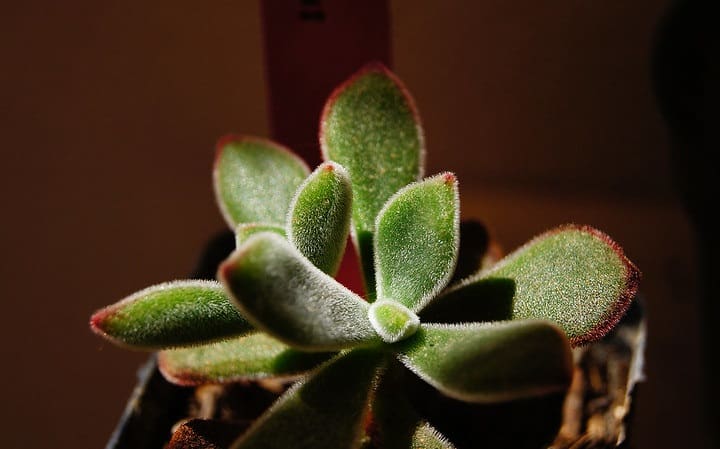
Crassula rogersii is a small succulent bush that has many branches and can grow either flat on the ground or stand upright. Its stems are thick and red in color. The leaves of this plant are shaped like clubs, like the ends of a baseball bat. They feel unique because they are covered in short white hairs, which make them look velvety and feel like felt.
In its natural environment, Crassula rogersii forms a small and compact cushion-like shape that can reach a height of 6-12 inches. The plant can stay green even in shady areas, but it looks its best when it gets plenty of sunlight. When exposed to lots of sunlight, the tips of the leaves turn red, adding a beautiful touch of color.
During mid-summer to autumn, this plant produces tiny yellow flowers that look like stars. These flowers grow in small clusters at the end of thin stems. It’s important to note that different varieties of this plant have been created by mixing it with other plants to form hybrids.
Crassula sericea
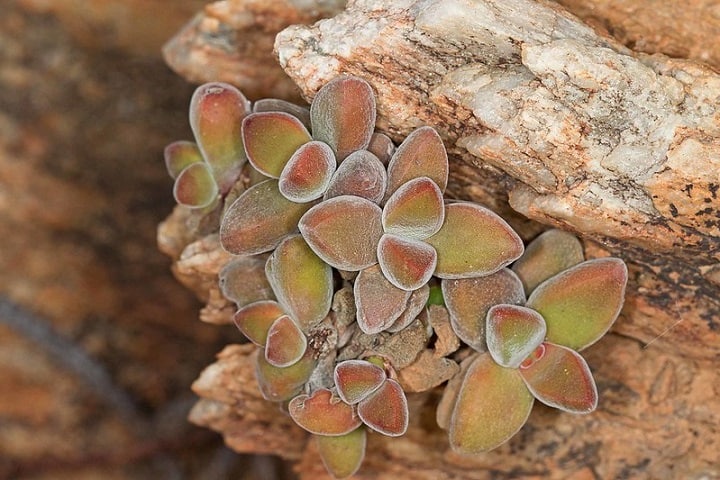
Crassula sericea (var. sericea) is a small, long-lasting succulent plant that can grow up to 8 inches high. It often has many branches and forms rounded tufts that spread out in a circular shape. The leaves of this plant are covered in a dense layer of tiny hairs and are found at the ends of the branches. The leaves are flat, a bit rounded at the tips, and have a brown edge. Sometimes, when the plant gets older, the stems become hard and woody, and they don’t have any leaves on them.
One special feature of Crassula sericea is its petals. These petals have unique parts that stick out, called dorsal appendages, which help identify the plant. Typically, the plant has a yellowish-green color, which is commonly seen in the wild. However, all the different variations of this plant are worth growing because they each have their own beauty. The leaves of Crassula sericea can look similar to leaves from other species, so it’s easy to get them confused.
Crassula setulosa
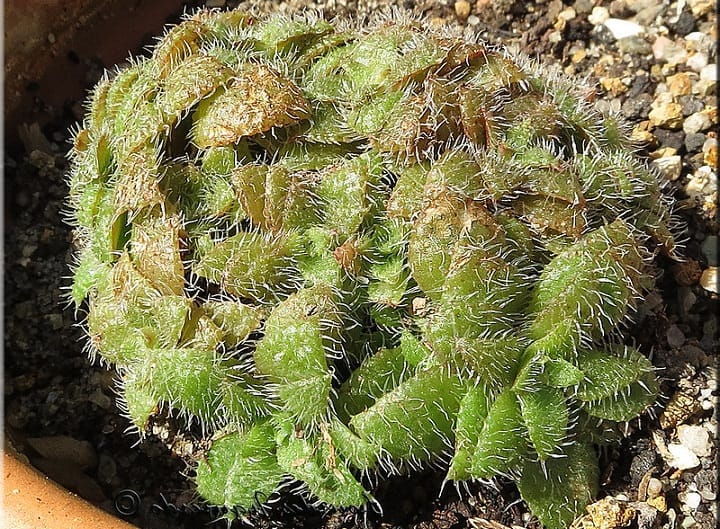
Crassula setulosa is one of the fuzzy succulent plants that grow small rosettes of thick, oval leaves. These leaves are usually less than an inch long and have fluffy white fringe on the edges. The plant can form dense cushions or mounds that are sometimes as wide as 16 inches and 2-4 inches high (10 inches when it flowers). In the summer, it produces small flowers that are either white or reddish. These flowers turn into capsules that release tiny, dust-like seeds.
The entire plant is covered in tiny hairs, although sometimes the larger leaves may be smooth on one side. This species has lots of variations when it comes to its leaves, which can differ in size, shape, and hairiness. Some of these variations are not really important for classification and are just normal differences. There are five recognized types of this plant: the main type, Crassula setulosa var.jenkinsii, Crassula setulosa var. deminuta, Crassula setulosa var. rubra, and Crassula setulosa var. longiciliata.
Crassula tecta
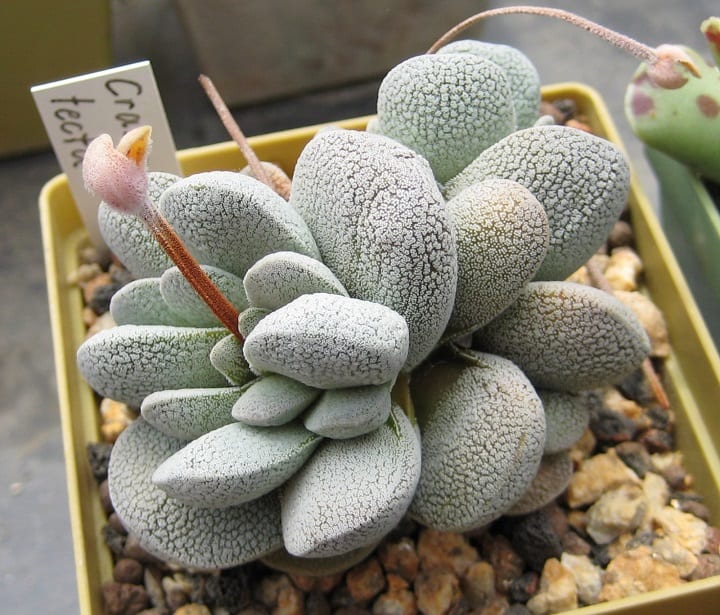
Crassula tecta is a small plant that looks really lovely. It has thick, greyish-green leaves that are about 0.8-1.2 inches long. These leaves are covered with little bumps that look like the scales on a butterfly’s wing. This plant is also more succulent (full of water) compared to other plants in the same group.
The plant grows slowly, but over time it forms low, compact clumps that are about 2 inches tall and 2.4 inches wide. These clumps look completely different from any other types of Crassula plants. When it flowers, it has a cluster of several white flowers at the end of a stem that is about 4 inches tall. There are different varieties of C. tecta, and each one looks slightly different from the others.
Crassula tomentosa
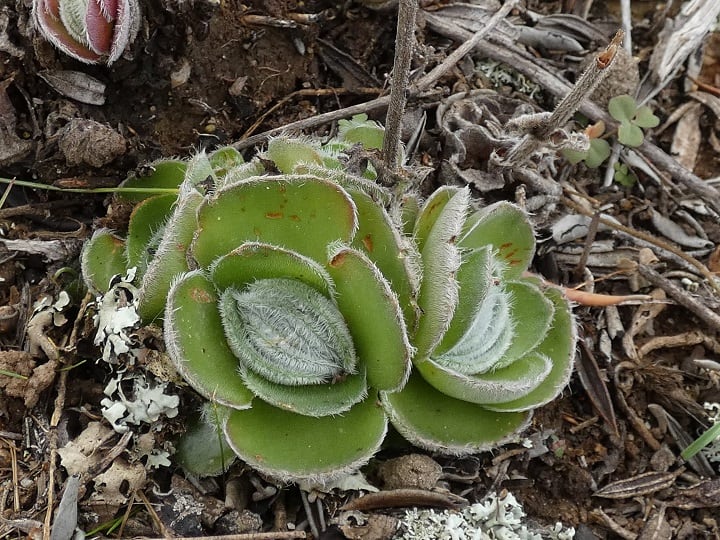
Crassula tomentosa, also known as woolly crassula, is a type of succulent plant that lives for many years or sometimes just two years. It forms one or a few, and rarely many, tight clusters of greyish-green leaves. These clusters can grow up to 24 inches tall, including the part that produces flowers. The entire plant is covered in stiff, bendable hairs that point backward.
Something interesting about this plant is that each individual cluster of leaves only blooms once in its entire life. After it flowers and produces seeds, it dies. Crassula tomentosa is a species that comes in different varieties. They may have slightly different amounts of hairiness and the leaves can vary in size and shape.
Crassula velutina
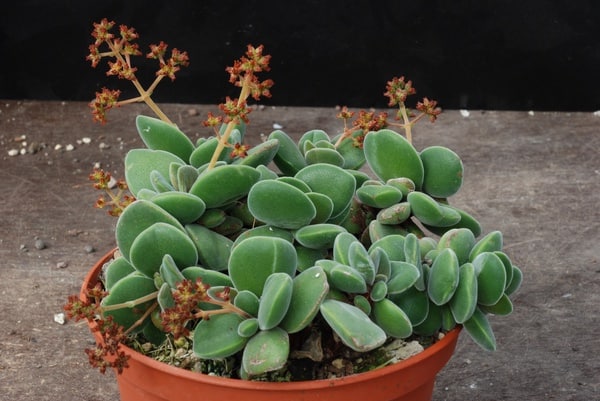
Crassula sericea var. velutina is a succulent with fuzzy leaves that is different from another variety called var. sericea. One main difference is that var. velutina is smaller in size, growing up to 6 inches tall including the part that produces flowers. Its growth pattern can either be spreading along the ground or standing up with a few branches.
The stems of this plant are very short, usually less than 1.2 inches long. It has larger, flattened leaves covered in soft, velvety hairs. If you were to look at these hairs closely with a special magnifying tool called a jeweler’s eyepiece, you would see that they are very tiny and appear dense and upright.
When this plant blooms, it has yellow petals that come to a point. Interestingly, these petals usually don’t have any extra parts sticking out on their backs.
Echeveria cv. Bombycina
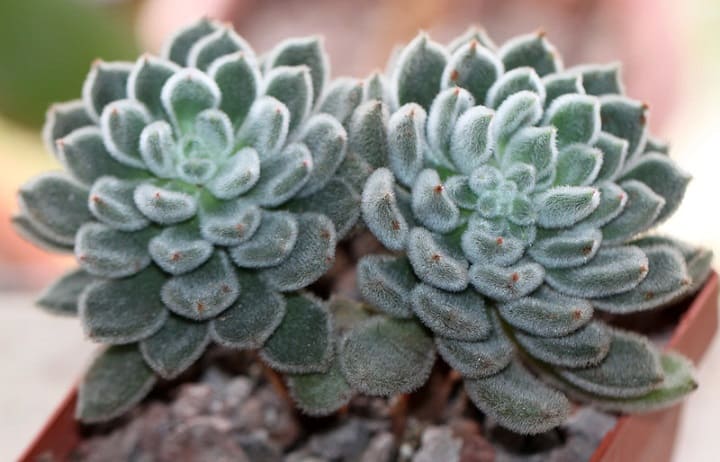
Echeveria cv. Bombycina is a special type of plant that comes from a mix of two other plants called Echeveria setosa and Echeveria pulvinata. This particular plant is a hybrid, which means it is not a true species, but a combination of different plants. Sometimes you might see this plant without the ‘x’ on the label, which is a sign that it is a hybrid. Many collectors might not realize that it’s not a true species.
E. cv. ‘Bombycina’ is a bit fuzzier and its rosettes (the tight clusters of leaves) are more compact compared to its relative plants. It looks similar to another plant called Echeveria pilosa, which is also like Echeveria setosa, but with a shorter stem. The rosette of this hybrid is bigger and denser, and the leaves are larger and wider. They are also covered in lots of hairs, which gives it a softer and more pleasant look.
One great thing about this plant is that its flower stems are not very tall, unlike those of Echeveria setosa and Echeveria pilosa. Sometimes, the flower stems are even very short, which adds to its charm. The flowers themselves are radiant and look similar to another plant called Echeveria pulvinata, with a similar shape, size, color, and texture.
Echeveria coccinea
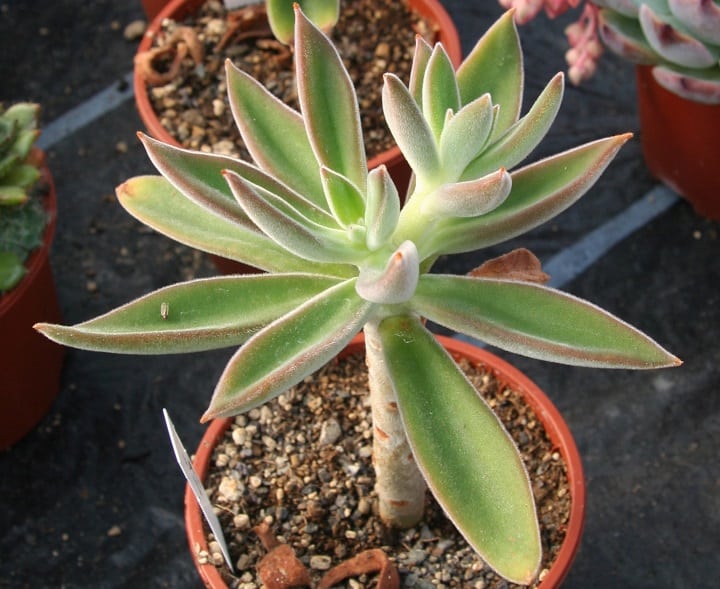
The Echeveria coccinea is a plant that looks like a small shrub with rosette-shaped leaves. It can grow up to 24 inches tall or even taller. As it grows, the stems start off standing up straight, but later they bend down and spread along the ground, and even take root in the soil to create a spreading mound shape.
When you touch the plant, it feels soft and has tiny hairs on its surface, except for the inside of the flowers. This species can look different depending on where it grows naturally and how it is taken care of. Even plants that are labeled as E. coccinea can have quite different stem and leaf shapes, which can vary based on the specific type of plant and the conditions in which it is grown.
Echeveria setosa
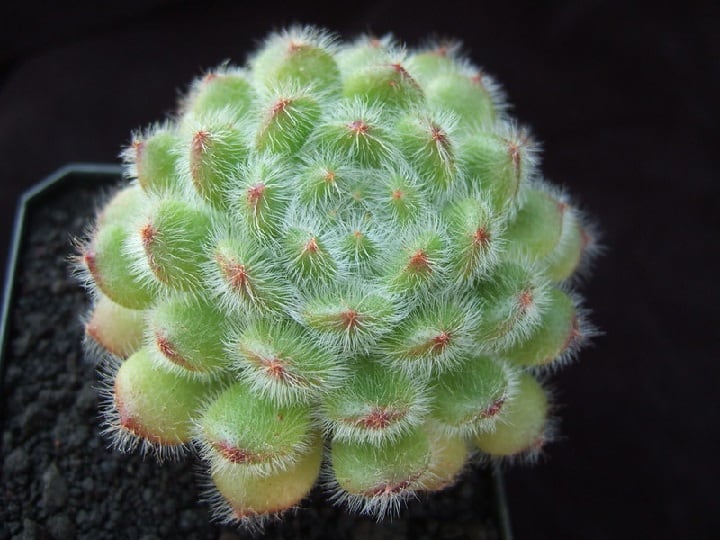
Echeveria setosa is a unique type of plant that grows in tight clusters without much stem. It is a succulent plant that forms dense mounds. One interesting thing about it is its texture – some plants are almost smooth, while others are very fuzzy with stiff, shiny white hairs. This variation in texture can depend on the specific variety of the plant.
As this plant grows, it produces new plants called offsets from its base. These offsets allow it to cluster together and form dense mounds.
Kalanchoe eriophylla
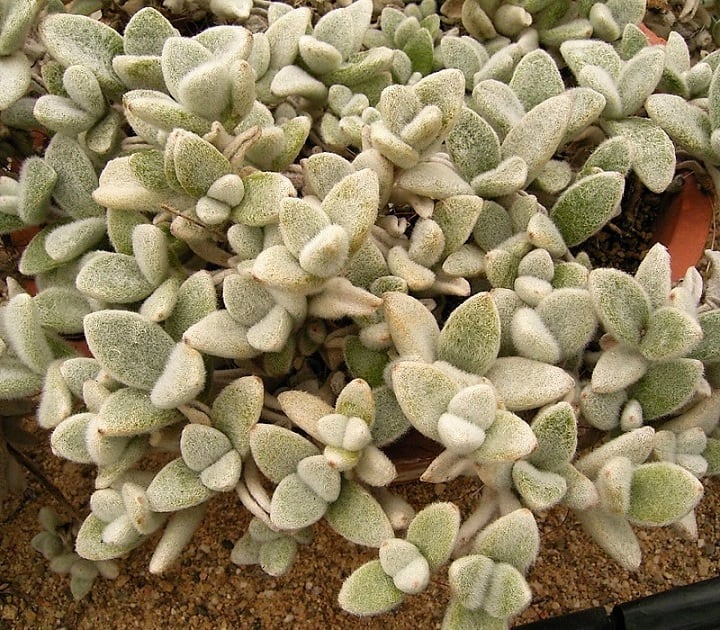
Kalanchoe eriophylla is a beautiful succulent plant that originally came from Madagascar. It has thin and furry stems covered in a layer of soft, white hairs. The leaves of this plant are thick and fleshy, and they also have a fuzzy appearance because they are covered in the same whitish hairs. In fact, it’s one of the furriest succulents you can find!
Although it does produce flowers, they are not very plentiful, and they are a simple pink color. However, despite the lack of showy flowers, this plant is still very appealing and attractive in its unique furry way.
Kalanchoe tomentosa
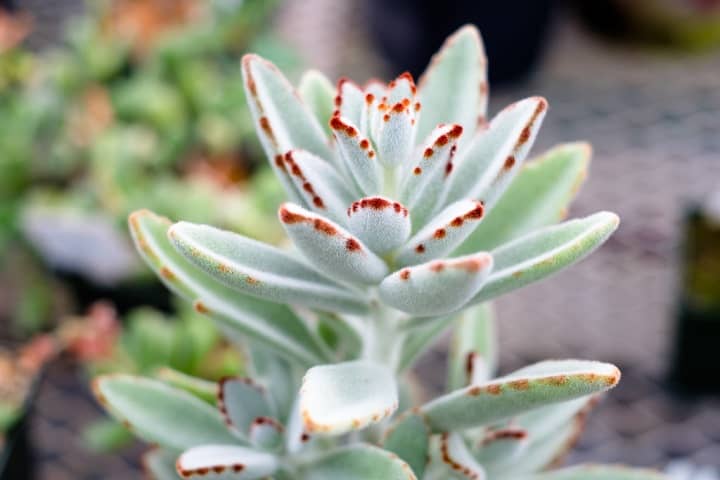
This succulent plant is truly stunning and grows slowly over time. It’s a perennial, which means it comes back year after year, and it has thick, furry white hairs covering its leaves. Eventually, it forms a small, upright shrub that can reach about 14-18 inches in height (in nature, it can grow up to 3 feet tall). Because of its fluffy leaves, people often refer to it as the Panda Plant or Pussy Ears.
The thick covering of hairs on the leaves serves an important purpose for the plant’s survival. In its dry environment, it needs to conserve as much water as possible. The dense mat of hairs slows down the movement of air directly across the leaf surface, which helps reduce water loss through evaporation. The hairs also create a protective layer that shields the leaves from the harsh external conditions. Additionally, the white-silver appearance of the leaves reflects light, preventing them from overheating. All these adaptations help the plant thrive in its environment.
Sedum mocinianum
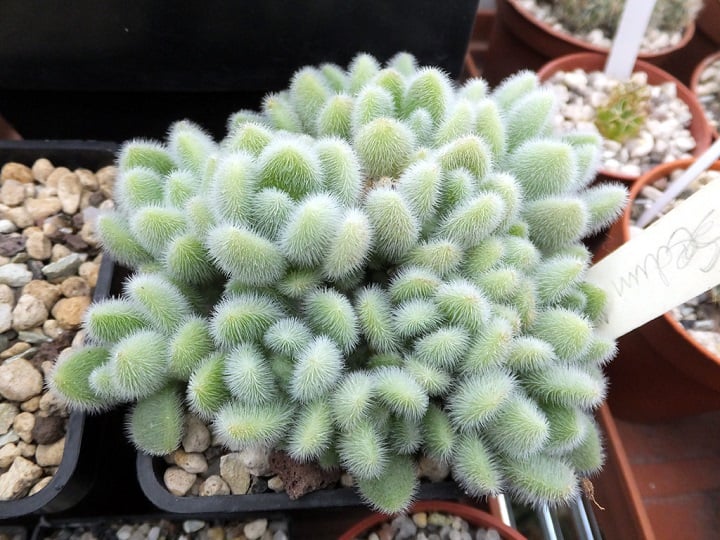
Sedum mocinianum is a lovely succulent with fuzzy leaves that is often considered one of the most attractive sedums. It is a plant that grows as a spreading mat and comes back year after year. The stems hang down and can reach up to 31 inches in length. In the winter or around April in Mexico, it produces small white flowers with dark red centers. This is a delightful sight and a sign that spring is here!
One special feature of Sedum mocinianum is its dense covering of white, transparent hairs that are about 0.02 inches long. You can find these hairs on every part of the plant, except for inside the flowers. This characteristic helps set it apart from other plants and adds to its unique beauty.
Tylecodon leucothrix
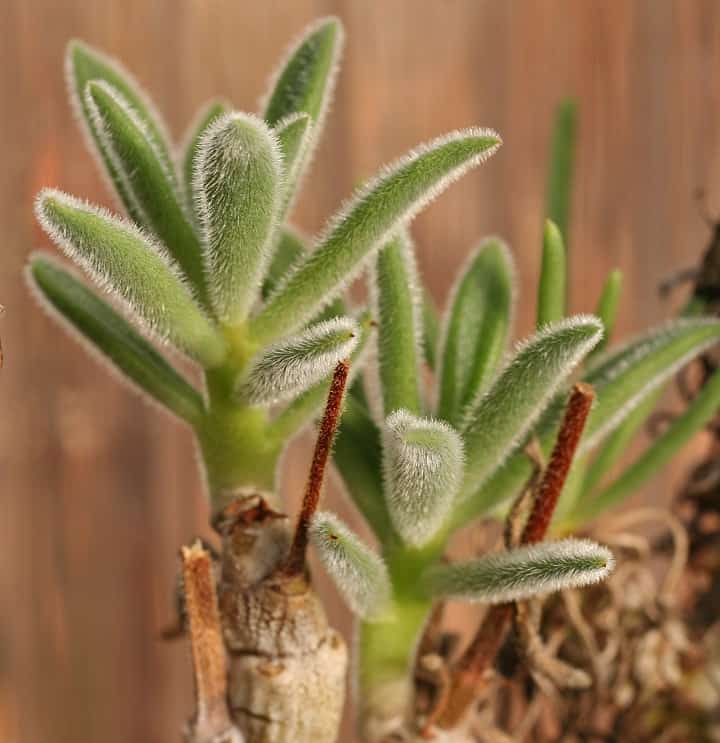
Tylecodon leucothrix, also known as bunny ears or doubossie (little dew bush) in Africa, is a special type of fluffy succulent plant. It’s like a small shrub that grows from an underground tuber, or a swollen storage root. The plant itself can reach a height of about 8-12 inches (sometimes up to 12 inches or more), and its stems have a peeling bark.
The leaves of this plant are thick and fleshy, and they’re covered in lots of dense white hairs. During the hotter months, the leaves tend to become dry and fall off. In the summer, Tylecodon leucothrix produces pretty tubular flowers that can be white or slightly pinkish in color. They bring a lovely touch of beauty to the plant.
One interesting thing about this plant is that its leaves have hairs that collect dew. That’s why it has the nickname “doubossie” or “little dew bush” in Africa. This phenomenon of dew collecting on leaf hairs is quite fascinating.
